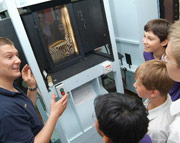Boys from The Perse School in Cambridge got the chance to be engineers for a day last week, when they met Cambridge University researchers who are trying to design a ‘Silent’ Aircraft.
We hope to use that excitement to get future generations interested in the idea of becoming engineers.
Paul Collins, project manager of the Cambridge-MIT Institute 'Silent' Aircraft initiative

Twenty-three boys from Year 8, accompanied by technology teachers David Gant and John Southworth, visited the Department to test out their ideas for making a passenger aircraft fly more quietly.
They took with them model ‘fairings’ – or shields – which they have been designing and making during their technology lessons this term. These are intended to fit around an aircraft’s undercarriage to cut down the noise that it produces during approach and landing. During their visit, the boys got the chance to test out their models in the University’s Markham wind tunnel, helped by researcher Alex Quayle, to see if they would succeed in reducing noise levels.
Researcher Tom Law also showed them a smoke tunnel, and showed the boys the way a model aircraft wing creates dramatic eddies and turbulence depending on its angle as it cuts through the air at high speed.
The boys were visiting researchers working on the Cambridge-MIT Institute’s ‘Silent’ Aircraft Initiative, and were invited by the project manager Paul Collins. He says,
“When we tell people that we are working on designing a passenger plane that is radically quieter than today’s aircraft, they are immediately interested and excited. We hope to use that excitement to get future generations interested in the idea of becoming engineers. As a result of this pilot exercise, we would like to roll out a project nationally next year.”
David Gant, Head of Technology at the Perse, says,
“This has been a very good project so we were very pleased when Paul approached us. It ties in with some of the work we have been doing in physics, and it also gave the boys the opportunity to use a vacuum former to make their models.”
The boys certainly enjoyed their visit. Freddie Bowden, 13, says,
“It was really cool. First we heard about why the undercarriage was so noisy, because of all the wires and hydraulic pipes on it. Then we made model fairings to see if they would reduce the noise.”
David Chapman, also 13, added,
“It was good fun, except that some of the models turned out a bit wrong. One of them has turned out looking a bit like the Batmobile!”
Michael Franklin, 13, added,
“We won’t get the results from the tests in the wind tunnel for a few days. But we could see the graph that was produced during the tests, and the fact that the ‘spikes’ made on the graph by the normal undercarriage were reduced a bit when the models were tested.”
Perse school technology teacher John Southworth adds,
“It has really demonstrated the importance of reducing the environmental impact of technology – in this case, cutting the noise of an aircraft. And meeting design engineers today, who are working on the same challenge that they have been tackling, has shown the boys that designing an aircraft is perhaps not that far removed from something that they could do in future.”
The photograph on this pages shows researcher Tom Law (left) demonstrating the smoke tunnel to Perse boys Romesh Jayasundera, Josh Holmes, Stephen Kemp, and David Katz.

